One of the First Night Scenes Painted in Art
The Colors of the Night
Mastering the Nocturne
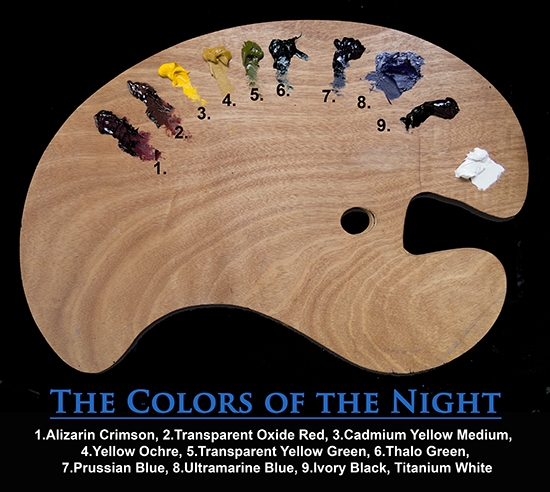
Weastward tend to pigment nocturnes year round, simply for most artists, the first warm, moon-lit nights of spring indicate that nocturne painting season is open up once more. We firmly believe that more painters should try painting at night because there are many learning benefits in the practice for an artist. For instance, darkness forces us to focus on the large masses kickoff. That discipline helps the states to see the daytime world with greater clarity. At dark we also learn to create simplified compositions which are stiff in design instead of superfluous details. That skill improves all of our paintings. We learn how to use and exploit a limited color and value palette to suggest spatial depth and form.
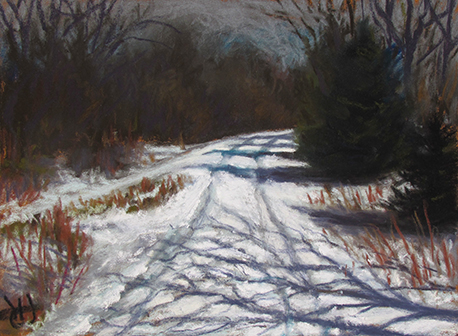
Moonlight, January Pastel John Hulsey
All of the truly accomplished painters whose work we admire have these skills well in hand just it may have taken them years to principal them. What an opportunity, then, is the nocturne! Similar annihilation, it takes some trial and error to effigy out the palette colors and the technical approach to night painting, so nosotros decided to give y'all a "leg-up" by introducing our nocturne palette colors. Nosotros are illustrating hither a larger set of palette colors than one might unremarkably need, to try and cover a variety of different lighting situations —especially city street lighting which can vary these days from yellow to blue in cast, depending on the type of lamp. Transparent Yellow Greenish, Cadmium Yellow Medium and Ultramarine Bluish are optional colors.
A few nights ago we taught the first of three plein air nocturne tutorials to some students who had never painted at night before. We chose an urban site for its accessability, subject matter and wide diversity of lighting. It is of import besides to consider security when selecting a site to paint at night—especially i near two confined, similar ours was. In that location is more than security in painting with a grouping, and if we are wearing our Night Light hats, then we have another security reward since our lights tend to bullheaded anyone nosotros wait at! That being said, nosotros have never experienced any issues in the years we have painted at nighttime. In fact, the people who tend to exist attracted to our activity are always simply curious virtually the painting process.
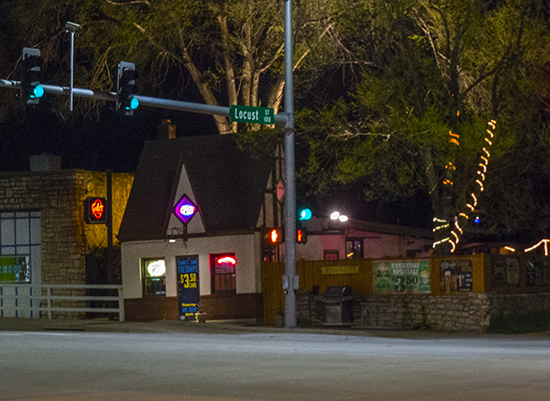 My Nocturne Subject
My Nocturne Subject
I chose to paint the interesting footling high-peaked edifice which may accept been a gas station in the terminal century, just which now is a bistro. Information technology was a challenging subject field because of all the different colors of lighting, from neon, to halogen floods, white Christmas lights, traffic signals, walk lights, and both sodium vapor and LED street lamps illuminating the busy intersection! A cornucopia of calorie-free temperatures and intensities.
While it may be tempting to simply snap some photos and then try to paint the night scene back in the studio, this is a foolish assumption. Some modernistic digital cameras tin can take remarkably good photos at night—especially from a tripod, but they will bear little resemblance to the scene every bit the centre can see it. The average digital camera sensor (eye) is designed to capture light in simply 255 steps of value from pure black to what it registers as pure white, and these only in a limited range of intensity. But the camera is nearly blind in the dark. Shooting at night, we are forced to manually increase the ISO exposure values up so high— above 600—that footling speckles of color (noise) announced in all of our darks, while the lightest areas tend to have no detail in them at all. If we effort to lower the ISO and use a flash, the results are unnatural and useless for nocturne painting. Not good. Plus, the camera flattens out space into two dimensions and has trouble registering subtle color shifts or distorts what is there.
When we pigment en plein air at night, nosotros pigment in a very low-low-cal situation. We utilize just enough light to illuminate our piece of work and our palette and no more than. Our eyes gradually conform to this and enable united states to perceive a remarkable range of dark values and luminosity—something a photographic camera cannot do. This ability helps us to produce the near life-like results in our paintings. Working in a brightly lit studio from a photograph is nothing similar a existent nocturne, and it shows right away.
In any dark state of affairs where there is some bogus light or burn light, the colour-sensing cones in our eyes can register colour and that becomes part of the bailiwick involvement in the nocturne. When we paint only in moonlight, however, the luminance level is then low that our color cones shut down and we see but with the rods. The approximately six million cones in our eyes are colour and particular sensitive and work only in calorie-free. The 100 million or more rods in our eyes are 1,000 times more sensitive than the cones and are responsible for our night vision, but are non color sensitive.
Because of that, nosotros become nearly color bullheaded under low levels of illumination. Every bit the calorie-free dims, the rods take over from the cones, and before color disappears entirely, our color perception seems to shift toward the blue-green spectrum. Furthermore, contrast relationships are often reversed, with the bright object in sunlight becoming the dark object in moonlight and so on. If you are skeptical, try looking at a red rose or some other bright warm-colored bloom with which you are familiar under moonlight. If you lot retrieve that yous are able to run into anything other than a nighttime grayish tone, your brain may be overcompensating for your eyes. You are basically seeing what you think or imagine it should expect like. Read about the Purkinje Outcome in Perspectives No. 300 - The Blueish Shift. Why and then exercise we seem to be able to make out some cool colors—dark dejection, dark yellows, dark greens and even cool browns under moonlight? It is a scientific mystery which remains yet to be fully understood. Give thanks goodness we tin, though, or there would be no night painting for usa. Thus, our nocturne palette is fabricated of those dark and cool colour combinations.
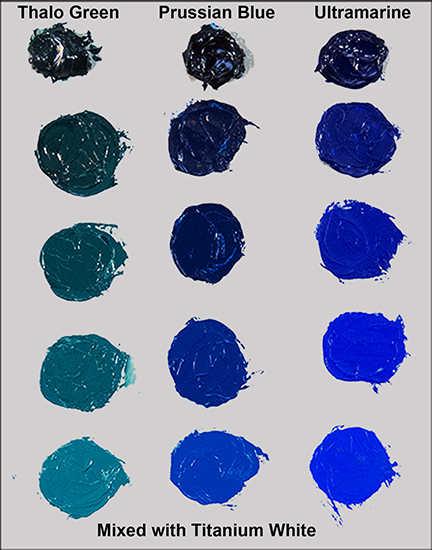
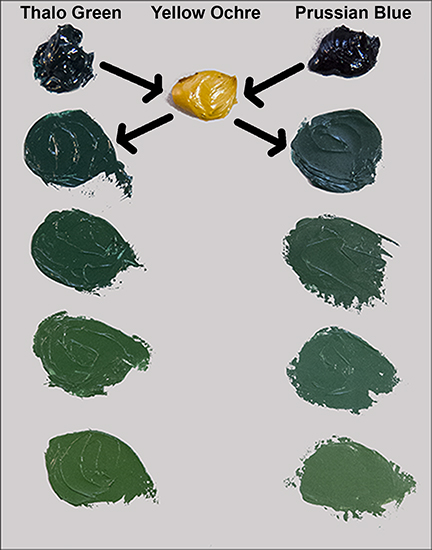
These 2 color strings illustrate some of the deep nocturnal colors we need to be familiar with. On the left are our three darkest cool colors, Thalo (or Pthalo) Green, Prussian Blueish and Ultramarine every bit they appear very gradually mixed with touches of Titanium White. Depending on your location and the amount of low-cal pollution from town, one of these volition probably match your overall sky tone. On the right are some common mixes of dull, absurd green, using Thalo Light-green and Prussian Blue mixed gradually with Yellow Ochre. The Thalo greens are slightly warmer than the Prussian greens. Whatever of these can be further darkened with the add-on of a neutral black, such every bit Gamblin's Chromatic Black. Ivory black is warm and will heighten the temperature at the same time—which may not exist desirable. Attempt these yourself earlier you head out into the night. They are easy to mix and will serve you well out there.
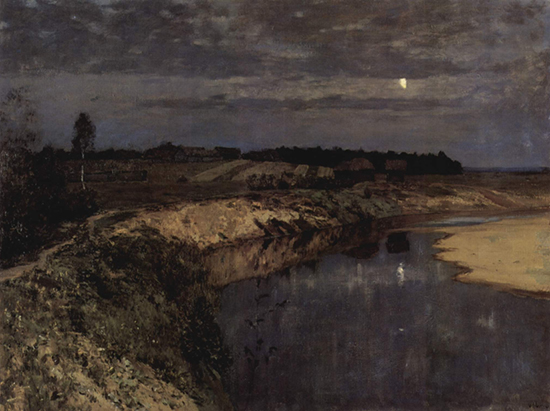
Silence 1898 (PD US) Oil Isaac Levitan 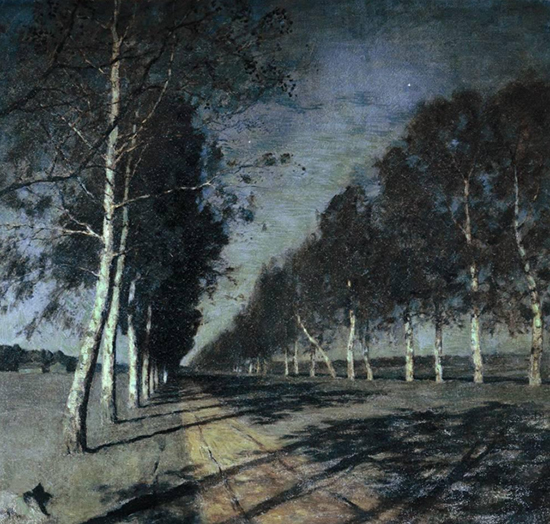
Moonlit Night 1897 (PD Usa) Oil Isaac Levitan
Any successful mural painting depends primarily on properly counterbalanced values more than color, and in a nocturne this is doubly and then. Unfortunately, about people tin can't perceive more than nigh 5 steps of value under moonlight, from the moon at the brightest point, to whatever pure blacks we meet. That simply leaves three values to describe everything else, and you might exist surprised how few truly black masses are out there. In our opinions, five values are not quite enough to create a convincing sense of space and depth in a painting. What is required of u.s. then, is to expand the value set before usa, artistically. This is easier to do than it sounds! Once we have established all of our largest shapes and masses, we only break those masses into smaller ones by adding some actress color or value shifts, whether we actually run into them or non. We may have to use our imaginations a bit here—that'south function of the fun. These little shifts add together detail to an otherwise blocky painting and then serve usa on both fronts.
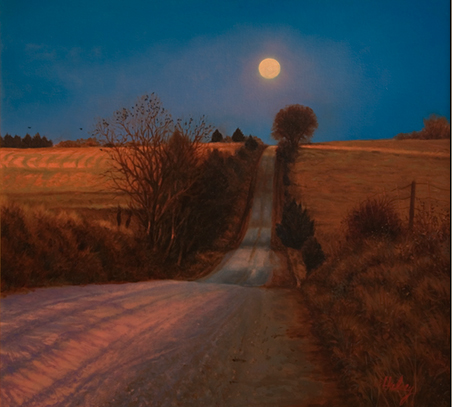
Moonrise Route Oil J. Hulsey
As for colour, under moonlight there are few if any warm tones, so artists have been arbitrarily adding them to their night paintings for centuries. The fox is to make them seem natural. Since most people are unaware of the Purkinje Issue, this is not as tough of a job as it would seem. Moonlight itself tin can always be warmed upwardly some. Believe it or not, moonlight is actually warmer than sunlight! The color temperature of moonlight has been measured at a warmer 4100 to 4150K versus the color temperature of sunlight which is measured at over 5000K - a bit cooler. Often a lamp or camp burn down can be placed off in the distance to add together an accent of color. Fireflies are fun to add to paintings around hither in the summer. The possibilities are upwards to y'all.
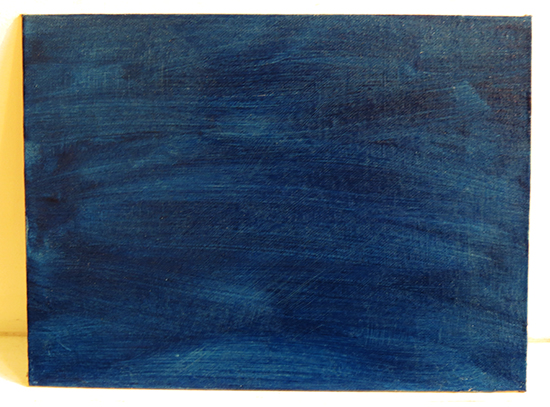
Linen Panel Toned with Prussian Blue
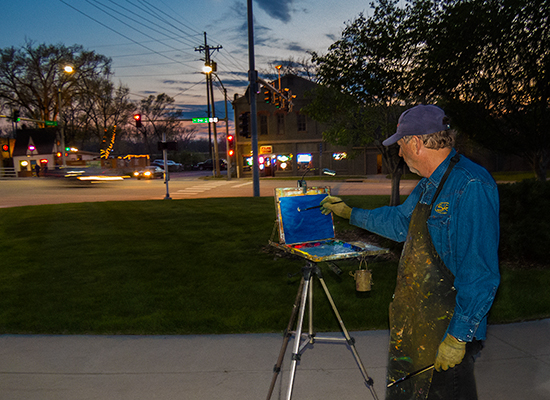
Creating Light Areas by Removing Some Colour
Toning your white panel or canvas before start is a expert thought and volition help you use the right values in your block-in. I often apply a warm orangeish tone to create a color vibration dissimilarity with my absurd blues, merely for this sit-in I decided to take the contrary approach and tone my linen panel with Prussian Blue mixed with some NeoMegilp medium. Applied vi hours in advance, the NeoMegilp had set up sufficiently enough that it kept my Prussian Blueish from easily mixing into every other color, but remained removable with thinner. My start job, afterward I had sketched in the outlines of my bailiwick with some dark blue, was to remove colour from those places where I wanted bright lights. This immediately helped to create a sense of dark punctuated by light sources.
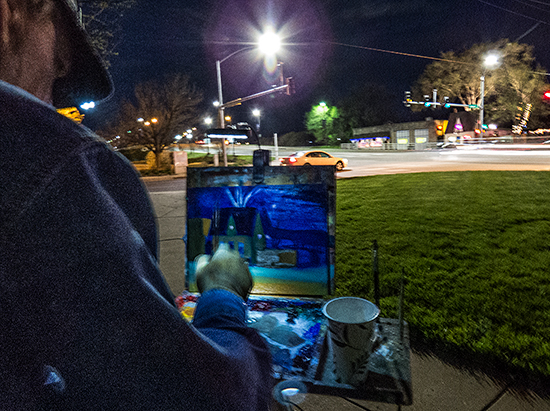
Demonstrating the Process
In a higher place you can come across the light areas I had previously removed inside the developing painting. Right after the lights are removed, I established the darkest darks. This simplifies my job in any painting day or night. One time my ii extreme values are in, all other values are compared to them and must fit in between them. The area which gave me the most trouble was the street. It was lit past both an orangeish sodium vapor street light and a new, cooler LED street light. I had to go that blended just right as information technology was a fairly big mass in the bottom 3rd of my panel and influenced the colors on the footling bistro building.
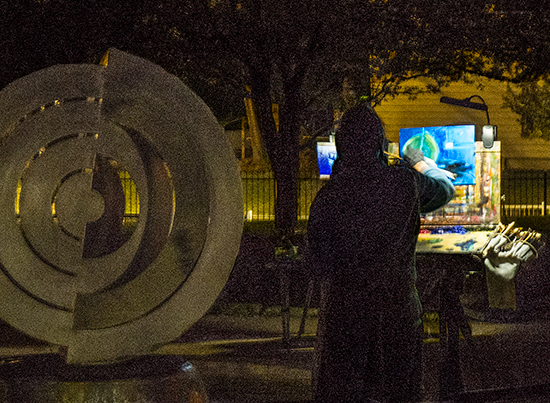
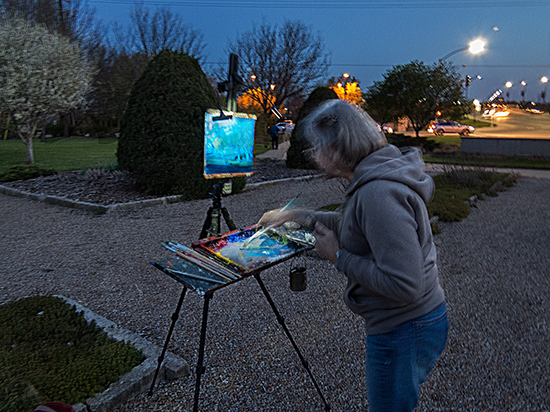
In between demonstrating, Ann and I circulated among our students to give them assist with their paintings. Each pupil picked a different scene to piece of work on. Anybody did remarkably well with this assignment considering it was a first-time experience—in fact, amend than I did my first nighttime out. Being prepared to handle a new feel like this is very important to getting the nigh out of it and can mayhap atomic number 82 to a life-long love of nocturne painting. Nosotros enjoy teaching it as much as painting itself —maybe more, since we are in such good company. And good company makes working in the night of the night a warm and friendly experience.
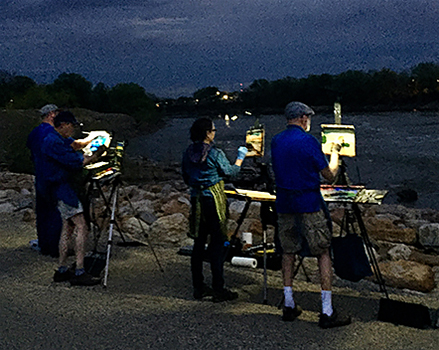
Our Students Painting the River on the 2d Night of Grade
On the second night nosotros took the students down to the hydro dam area on the Kaw River virtually downtown Lawrence. The dam was built on elevation of a natural ledge of limestone in the river which prevented steamboats from going any further upstream. The mechanical energy from the falling water was harnessed to run all kinds of chugalug-driven equipment in the flour factory and other buildings in early on downtown Lawrence. Today, the operation serves 2 hydroelectric power plants and the dam elevation tin be automatically raised or lowered.
This is a great spot which is in an elevated position above the river on a wide gravel roadway. The area has been developed every bit a walking/biking path then at that place are friendly people around walking dogs or jogging, even in the evening hours. This spot allows usa to pigment the lights on the bridge over the river and some of the lit windows in city hall and the hydro power plant direct across from usa. Rhythm and pattern. The reflections in the river from these lights, especially, make the limerick all the more interesting and challenging to paint.
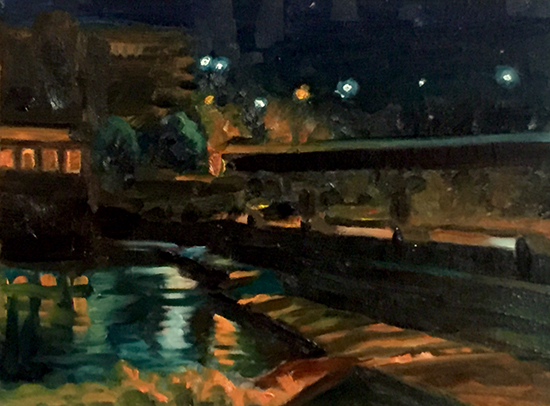
Night Study Oil John Hulsey
Above is my nine x 12" oil demonstration painting of our subject. I have lightened all the values hither and extended the value range to add together details. Stiff winds from an budgeted storm fabricated this evening a claiming equally nosotros had not brought stone bags along to weigh down our easels - a couple most blew down while we were painting. We were continually under threat past a severe storm which threw out lightning all around in the altitude. As luck would have it, the storm parted in two simply every bit it neared our position and went effectually united states. Not even a drop of rain!
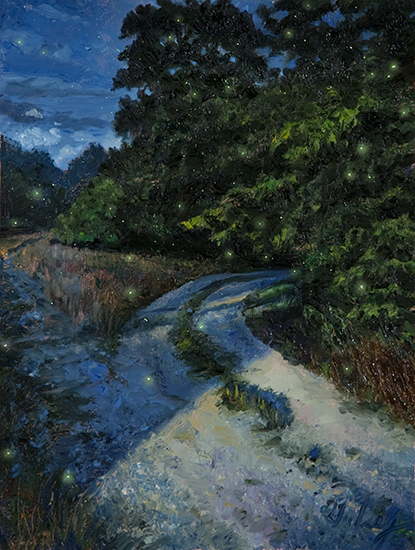 Nocturne: Dark Ramble - Fireflies Oil John Hulsey
Nocturne: Dark Ramble - Fireflies Oil John Hulsey
The painting higher up is a pure moonlight nocturne—no human-made light around, so I was seeing only with the rods in my optics. I call up you lot can see that I artificially added some warm colors to this slice to brand information technology less cold-looking, and raised the values up quite a bit and so the painting would look "right" under indoor illumination levels. The fireflies were added later on the painting had stale. If you are interested in picking upwards some nocturne painting skills of your ain, but could use a piffling guidance, download a copy of our A Primer on Night Painting - Nocturnes in our Store, or order a softcover if you adopt. And then take hold of a friend and go out there. The night is waiting!
Copyright Hulsey Trusty Designs, L.L.C. (except where noted). All rights reserved.
Source: https://www.theartistsroad.net/articles/colorsofthenight



